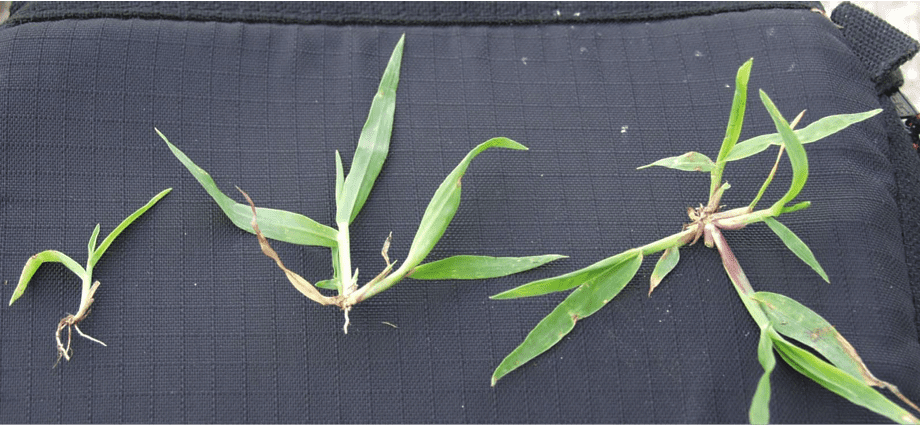Making the Most of Pre-Emergents: Save Time and Some Budget With These Comprehensive Tips

If superintendents want to control weeds like crabgrass on their courses, they must apply pre-emergents. There’s no getting around it. However, superintendents can use a few tips to save time and a little budget when making pre-emergent applications.
Pre-emergent Application Timing
Pre-emergent products maintain control of weeds and undesirable grasses by placing a chemical “blanket” in the soil/thatch. As the undesirable plants germinate and begin to grow, they will come into contact with the chemical “blanket” and be stopped in their tracks.
Because pre-emergent products create a chemical blanket in the soil before the plant germinates, pre-emergent controls need to placed in the area before germination of the undesired species. If pre-emergents are applied after the seedling has developed into a small plant, you are wasting time.
Also, crabgrass germinates when average soil temperatures reach 57 degrees Fahrenheit at a depth of 1 inch, so it is critical to make applications before this temperature.
Prodiamine and Dithiopyr
Prodiamine and dithiopyr are two popular pre-emergents that work differently. Knowing their differences will help you use them more efficiently.
Dithiopyr is a pre, and early-post product, which means it controls the plant before and after germinating. By using dithiopyr, the window of opportunity to get the product placed properly in the landscape is greater, which may also offer greater flexibility.
Prodiamine only prevents seeds from germinating. So, as in the pre-emergent description at the beginning of this article, prodiamine needs to be applied early in the season before crabgrass begins to germinate. After germination, dithiopyr would typically give you more effective results. Note: If you use a GDD tracker after you applied a pre-emergent application, and it says you’re early with prodiamine, that’s okay. Prodiamine does not break down until soil temps increase and microbial activity increases. This is true with other pre-emergents but especially true with prodiamine.
Physical Applications of Pre-emergents
When it comes time to pull out the pre-emergent and apply the product, superintendents should know a few things to make things easier.
Split applications can be beneficial. Dithiopyr applications approximately 4-6 weeks apart have been shown to improve seasonal control. Also, if you are in an area where, historically, the summer is pretty hot, spilt applications can create a significant benefit. A hot summer can break down the chemistry quicker and cause the products not to last as long.
Using penetrants increases your chances of success. More than one factor can affect the quality and the duration of both prodiamine and dithiopyr apps, and thatch is one of them. Who hasn’t been in a situation where you treated for crabgrass, and it still pops up on slopes or other areas? In this situation, typically, most of the pre-emergent never made it to the soil. It may have gotten tied up in the thatch or possibly experienced photodegradation. Whether you intend to spread your pre-emergent on a fertilizer carrier or spray it, the use of a quality penetrant will significantly enhance your results. When applying liquid applications of Corteva’s Dimension or ArmorTech’s Kade, use a penetrant like Hydro-Pak’s Command at 16-32 oz/A to increase the efficacy of these sprays.
Another factor that can cause pre-emergent failure is irrigation. Irrigation (and rainfall) are vital for success to get the pre-emergent chemical off of the surface and into the soil.
Try a liquid combination product in areas where complete vegetation control is desired like landscape beds, gravel paths, and walkways. ProDuece (Roundup and prodiamine) from NuFarm and Specticle Total from Bayer (Roundup, diquat, and indaziflam), provide a total kill active ingredient (Roundup and diquat) in combination with a pre-emergent (prodiamine or indaziflam). This provides control of actively growing weeds and grasses as well as extended pre-emergent control for the coming weeks and/or months. Spray applications of these types of products do require care as they do contain “non-selective” control agents that will harm desirable species.
Apply an application of any of the following products to see results.
- Dimension 2 EW 1-2 pints/A rate. Can be a split application of 2, 1-pint applications
- Fertilizer/Dimension combination such as 12-0-3 .125% Dimension
- Armor Tech Kade at a 1 lb/A rate
- Fertilizer/prodiamine combination such as 19-0-0 .37% prodiamine
Tools
A tool that can help predict the best time for applying pre-emergents in a specific area is the Growing Degree Day (GDD) Tracker. There are several great GDD trackers. Find one tracker here.
Another tool that won’t necessarily help you with timing, but could save you time is the old-school tool of writing down or just noting past applications. Monitor areas you have treated for results using maps, detailed notes, or pesticide records. By doing this, you will know where you’ve had crabgrass pressure in the past and can use a higher rate in those areas.
P.S. Pre-emergents are also useful in native or unmowed areas to assist in keeping undesirable plants out of those areas. Pendulum Aquacap from BASF is uniquely suited for this application with the “protective cap” surrounding the active ingredient assisting with the placement. Two applications (one spring and one fall) are recommended for areas that previously have not been treated.
*Special thanks to Advanced Turf Sales Reps Don Lawrence, Jason Bennett, Jim Hess, and Todd Fregien for their contributions to this blog.







